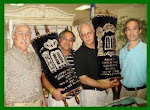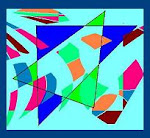

This is to honor our friend Wilfried Weinke of Hamburg, Germany, who recently won an award for his work as an historian and writer. He is one of the recipients this year of the Obermayer German Jewish History Award. My mother, Eva Spangenthal, is among a number of people who nominated Wilfried, specifically for his work in publishing and exhibiting material from the life and work of her father, Max Halberstadt.
As noted in the Obermayer transcript: "The two aims driving Wilfried Weinke's work as a historian are, on the one hand, to confront a young, mainstream German public with the Holocaust in ways that bring the country's former Jewish legacy to life, and, on the other hand, to rescue the names of forgotten German Jewish artists and intellectuals from the past."
Through the publication of Wifried's book "Verdrängt, vertrieben, aber nicht vergessen: Die Fotografen Emil Bieber, Max Halberstadt, Erich Kastan, Kurt Schallenberg" (Weingarten, Hamburg, 2003) and an exhibition of the same title in 2004, Max Halberstadt's work was at last presented to the public in a manner befitting his artistry and accomplishments. The most famous of all his portraits is the one of Sigmund Freud, shown in the composite above. Here follows a short side-story behind this.
The composite was made from a glass positive, which Max Halberstadt made in mid or late 1933 (either the 9th of May, or the 5th of September). We know this because Max wrote the date on the edge of the glass, along with the title and name of the subject (Herr Prof. Freud) as shown again below.

I believe he did this as he prepared to sell the originals, in order to raise funds, perhaps just to make ends meet, perhaps to escape Germany. In the context of events in Germany, the Nazis came to power when Hitler became Chancellor of Germany on Jan 30, 1933. The proverbial "writing was on the wall". The Nuremburg laws per se were not enacted till 1935, but in preparing to flee Germany, which my family did in 1936, my grandparents Max and Bertha, had much to do. In the course of his research, Wilfried found the letter Max Halberstadt sent to the Nazi authorities requesting to take his household and the contents of his photographic studio to South Africa. We also have the letters Max and my grandmother Bertha wrote to each other during that time, as he went to South Africa ahead of the rest of the family to prepare the way.
In selling the original negatives of his most important work, and in fleeing Germany in 1936, my grandfather's life's work was in large measure nullified. He set up his own studio in Johannesburg after briefly working in a commercial studio, but passed away in 1940 after barely 4 years in South Africa. My mother, Eva, who was 11 when she left Germany, left school at age 15, after completing the South African Junior Certificate (a level of school certification equivalent to a 10th grade certificate). She went to work in the garment industry to help support her mother and grandmother.
Over the years, Max Halberstadt's photographs of Freud would be used countless times. Much of the time, the images are used without crediting the photographer. But now we are grateful to Wil for his efforts. His book is a worthy memorial to my grandfather and his work.
In the meantime, Wil and his wife, Ursula Wamser, have published a book about the people and life of Hamburg's Jewish District, the Grindel, prior to the removal of its people by the Nazis, and its eventual destruction in the war. This book also features material from the life and work of my grandfather.
Our family is deeply grateful to Wil for his work. We enjoy his warm friendship, and wish him all the best on receiving the Obermayer award.
More links you may find worth visiting:
Eva and Max's biography on Goethe Institute website, and how Eva discovered Wilfried, and Wilfried in turn discovered Max H.



No comments:
Post a Comment